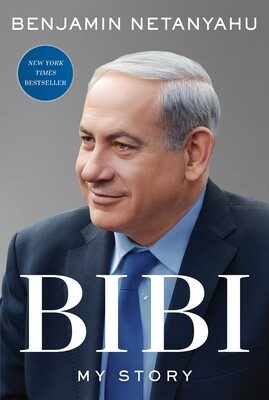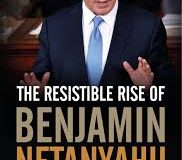The memoirs of politicians and public figures, it has been claimed, are among the most popular form of historical literature, although as the autobiography is both personal and political, one is – or should be – aware that he or she could reading a mixture of fiction and wishful-thinking. The reliability of a self-authored account is uncertain: an autobiography is inevitably a part-narcissistic enterprise.
Given that this book follows several non-authorised biographies, both in Hebrew and English, the reader can safely assume Netanyahu was not impressed by their efforts, felt too many errors were committed, was convinced their perceptions of his decisions and actions were wrong and, worse, purposely presented him, his achievements as well as his failures, to discredit or belittle them.
In addition, there was Joshua Cohen’s novel The Netanyahus: An Account of a Minor and Ultimately Even Negligible Episode in the History of a Very Famous Family which sought, while naming the family, to malign the Netanyahus in a more than nasty fashion, however entertaining he presumed he was being. As perceived by Daniel Trom, Cohen’s Reuven Blum was primed to see the elder Netanyahu as: ‘the dangerous Netanyahu’, one who possesses the ‘audacity’ Blum does not, who should ‘find a job anywhere, as long as it was not in Israel, because the man is, in short, reminiscent of the gifted but deviant and uncontrollable Jew.’ Do we hear an echo of today and just yesteryear in that?
At least Ian Black, reviewing in 2018 Anshel Pfeffer’s biography of Netanyahu, had the foresight to note ‘Bibi’s turbulent times are not over yet. Updated editions look certain’. Thanks to the Corona restrictions here in Israel, Bibi Netanyahu decided he could use some of his time to begin his autobiography which appeared just prior to him gaining a parliamentary majority to assure him a third, unprecedented, term as Prime Minister of Israel.
In Israel, perhaps the most surprising reaction to the book came from Haaretz’s Gideon Levy. Extreme non-Zionist anti-occupationist Levy, writing on 5 December, portrayed Netanyahu as Israel’s ‘last hope’, adding:
After reading Netanyahu’s articulate and fascinating autobiography, Bibi: My Story, it’s still possible to cling to the vestiges of the belief that perhaps there is another Bibi … Netanyahu is the last barrier, the last fortress, standing between loathsome, Jewish-fundamentalist racism and an ordinary apartheid state. Never before has so much depended on so little, on one person, so hated and so loved.
Indeed, the Netanyahu of Bibi, My Story is both political and principled, pragmatic and philosophical, polemical and platitudinal. We follow him through his life, that of his family and forbearers and that of his and his brothers’ childhood, experiences in America as a youngster as well as in Jerusalem, army and diplomatic service. An autobiography is supposed to present all that and Netanyahu does it well, very well. He is very well aware that he has been an object of fawning admiration and of hate and derision for over three decades.
He has been portrayed as a statesman and also a manipulating, devious, incorrigible dissimulator. He represents high hopes and lesser expectations. A subset of devotees has appeared, notably on social platforms, termed ‘Bibistim’ while all through 2020-21, the Prime Minister’s official residence at Balfour Street in Jerusalem, as well as those of his neighbors, were literally under weekly siege by movement activists, attacking the ‘Crime Minister’, a reference to Netanyahu’s various trials. And yet, as Levy notes in the above-mentioned column, ‘Netanyahu isn’t only Satan from the stories, he is also a statesman on whom we may pin a last, slim, but not impossible, hope.’
Netanyahu’s writing is clear and flows well. His narrative draws the reader into his deliberations, his doubts, his decision-making moments and his confrontations with army officers, politicians and presidents. He is cognisant of the praise and the blame he receives. His defensive rhetoric is measured. The reader is also drawn into various cultural backgrounds, life adventures, and ideologies that will be outside many readers’ frame of reference. Netanyahu is a Zionist rightest and his father a Jabotinsky Revisionist. More than just recounting his life, Netanyahu allows outsiders to gain an understanding of the ‘other’ Zionist camp. The book provides end notes for reliable sources of information and not just memories.
Ian Black, reviewing Pfeffer’s biography in 2018, wrote of a ‘master key to cracking the Bibi code … his identity as someone who has always stood outside the mainstream.’ Indeed, the key question in reading this autobiography was defined by Gal Beckerman reviewing Neill Lochery’s biography in 2016: has Bibi embraced an ethos of resilience for resilience’s sake? Is he an ideologue or a pragmatist? Or just a reinventor, a master of ‘evasion and zigzag.’
The book is a long read. We learn of his poor driving skills (p. 70), that he almost froze to death (p. 77) and was bitten by a scorpion (p. 79). His coup de foudre with Sara was when both found themselves at Schiphol Airport seeking out Gouda cheese (p. 227) although I am not sure it was of the Shoshana Brand. And while one could debate whether Ehud Barak is correct about him, it is nice to know that Barak did not storm the hijacked Sabena airplane (p. 81).
It might be easier and less dangerous to simply paint Netanyahu into a dark corner, the better to ridicule, lambast and deride. Netanyahu does, to his credit, admit to knowing about what people think about his thick hide (p. 410). But, after reading Bibi: My Story, that will not work. It will not work because the man who emerges from the book is not only likable, intelligent, well-read but someone who has done things few have managed to do, and he has done them well. So well, that he has come back for a third term as Israel’s prime minister, promising an eventful future four years, possibly.
He has already stirred up his ideological opponents at home and abroad. Here is Martin Indyk tweeting this past 27 November: ‘Whenever someone tells you that they feel sorry for Bibi because of all the hardliners he has to cope with … Netanyahu made this bed and invited all these extremist, racist, misogynist, anti-gay, anti-democrats to lie in it with him.’ Current politician and former IDF Chief of Staff Gadi Eisenkot invited one million demonstrators into the streets to protest (although another former IDF Chief of Command but former politician, Moshe Yaalon, reduced that to several hundreds of thousands).
Netanyahu touches almost all the bases. He complains of the negative press coverage he has received from the ‘mostly left-leaning journalists’ (p. 244) he feels hound him. He gives a slight apology to President Bill Clinton for the tone of his overreaction at one point (p. 255). He recalls the first Jonathan Institute Conference held in Jerusalem (p. 155), which I also attended, and which was the real beginning (besides his early Hasbara appearances when a student at MIT) of his public career.
One instance, however, where Netanyahu is tantalizingly less-than-forthcoming on page 422 is when he avoids informing the reader exactly what the gesture President Barak Obama made to him although, reportedly, it was the slicing-of-the-neck movement threat, or so claimed Mazal Mualem, as the Jerusalem Post’s Lahav Harkov has reported.
That wasn’t the only rough run-in with the Obama Administration. On p. 582, he recalls the ‘chickenshit’ remark of late October 2014 when an anonymous ‘senior official’ was quoted in The Atlantic that Netanyahu is ‘chickenshit…no Menachem Begin, he’s scared to launch wars’, words that Secretary of State John Kerry condemned as ‘disgraceful’ and that did not reflect his view or the view of President Barack Obama. The language, he added, was ‘unacceptable and damaging’. Few in Israel’s anti-right camp – and amongst our Jewish self-anointed intelligentsia – felt the same way about the insult.
Also missing is the meeting held in Amman with Jordan’s King Abdullah II and US Secretary of State John Kerry in November 2014 when ‘firm commitments’ had been made ‘to maintain the status quo at holy sites in Jerusalem’ as well as a second one in October 2015 which mulled steps, including round-the-clock video monitoring and Israel’s reaffirming of Jordan’s special and historic role as custodian of the site.
On 24 October 2015, the Prime Minister’s Media Advisor communicated Netanyahu’s statement that ‘Israel re-affirms its commitment to upholding unchanged the status quo of the Temple Mount, in word and in practice…Israel has no intention to divide the Temple Mount … We respect the importance of the special role of the Hashemite Kingdom of Jordan … and the historical role of King Abdullah II. Israel will continue to enforce its longstanding policy: Muslims pray on the Temple Mount; non-Muslims visit the Temple Mount.’ The agreement on surveillance cameras that would allow police to observe the development of potential violent activity was sabotaged by the Islamic Waqf officials beholding to the Palestinian Authority.
A few more nuggets provided by the book, and which could entice one to read it, would include his difficulties with Israel’s security establishment over a preemptive bombing of Iran (which he admits is, in principle, always a ‘difficult decision’); his brief conversation with representatives of the Yesha Council of Judea, Samaria and (then still) Gaza Communities at Wye (p. 314); what causes those seeking peace to fail, Ehud Barak ‘going low’ (p. 308); the reason for not voting against disengagement (the Bachar Bill, p. 393); Likudniks feeling Olmert was ‘too political and too calculating’ while Netanyahu saw him as ‘too decisive on Lebanon’ (p. 397); instructing Israel’s Embassy to place full page ad ‘For Jerusalem’ against US pressure (p. 441); characterising Naftali Bennett as someone who ‘postured as right-wing’ but this was ‘an empty pose’ (p. 490); his suspicion that someone in Israel’s security apparatus opposed an offensive strike leaked to the US (p. 486); and Obama’s ‘distorted prism’ through which he viewed the question of Palestine (p. 579).
Although the book provides the reader with footnotes, errors did creep in. One unfortunate phonological one appears on page 322 where the street name of his home is mistranscribed. Another is on page 513. The bodies of three teenagers kidnapped and murdered in 2014 by Hamas terrorists were not ‘hidden in a well in a Palestinian village’ but were buried in a water pool at an open agricultural field at a site between Bayt Kahil and Halhul. On pages 113 and 160, he uses the spelling ‘Beitar’ (usually reserved for the soccer club) rather than ‘Betar’, Jabotinsky’s Zionist youth movement.
With Netanyahu forming a new government coalition as an unprecedented third-time Prime Minister, a follow-up volume is to be expected.



































